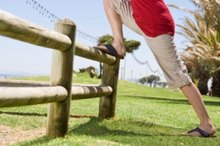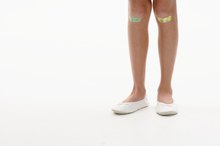Lack of Flexibility & Back Pain
Back pain, which is a woefully familiar feeling for many, is caused by a diverse number of factors ranging from past injury to lifestyle to individual anatomy. A lack of flexibility in the lower body, particularly in the hamstrings, buttocks and hip flexors, can actually cause lower back pain, which Len Kravitz, Ph.D. and Ron Andrews, M.S., P.T., of the University of New Mexico describe as "one of the leading causes of physical limitation in the U.S." Spine Health recommends holding individual stretches for 20 to 30 seconds.
Hamstring Help
The hamstrings are large muscles on the back of the thighs that, when tight, can pull on the pelvis and cause tightness and discomfort in the lower back. Regular stretching can gradually lessen this stressful sensation. To do a basic hamstring stretch, simply stand upright and then bend forward at the waist, letting your arms hang down. Reach for your toes, but do not force yourself to do so.
Hip Flexor Facts
Tensor Fasciae Latae Muscle Stretches
Learn More
Sitting all day causes your hips to stay in a flexed position, thus shortening and shrinking your hip flexors. When hip flexor muscles such as your iliopsoas are tight, they tilt your pelvis forward and compress your lower back. Stretch your hips by standing shoulder-width apart and taking a half-step back with one leg. Bend your forward knee, shifting your weight on to the back leg, which should be straight. Bend until you feel a stretch in your outer hip. Switch legs to get a balanced stretch.
Buttock Blues
The piriformis muscle, which runs through each buttock, helps to support the back and can contribute to back and leg pain when tight. Spine Health recommends stretching this muscle by lying flat on your back and crossing one leg over the other. Keeping your lower leg straight, pull the crossed leg up to your chest until you feel a stretching sensation in your buttock, taking care not to jerk your leg upwards. Switch legs after 20 to 30 seconds.
Caution Prevents Catastrophes
Pilates for Piriformis and the Gluteus Medius
Learn More
If you have a degenerative spine condition, injury or ongoing back or neck pain, consult your physician before embarking a new fitness routine. Always proceed with caution and listen to your body's cues. Sharp, painful sensations signify that you've gone too far. Warm-up before stretching with five to 10 minutes of light exercise, such as a brisk walk or quick jog. Never bounce when stretching, as this can tear muscle. The University of New Mexico recommends stretching at least two times a week.
Related Articles
References
Writer Bio
Michelle Wishhart is a writer based in Portland, Ore. She has been writing professionally since 2005, starting with her position as a staff arts writer for City on a Hill Press, an alternative weekly newspaper in Santa Cruz, Calif. An avid gardener, Wishhart worked as a Wholesale Nursery Grower at Encinal Nursery for two years. Wishhart holds a Bachelor of Arts in fine arts and English literature from the University of California, Santa Cruz.









